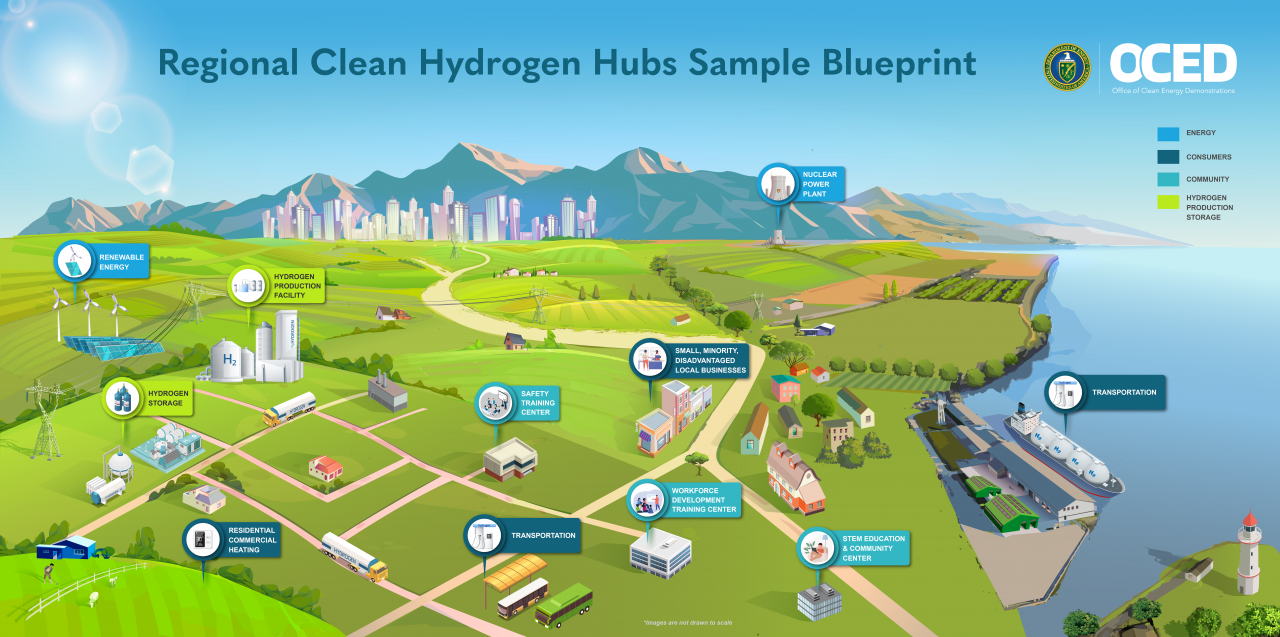
The US Department of Energy (DOE) announced $7 billion in aid to launch seven Regional Clean Hydrogen Hubs (H2Hubs) across the mainland and accelerate commercial-scale deployment of low-cost, clean hydrogen.
The hubs, funded by the Bipartisan Infrastructure Law, are expected to kickstart "a national network of clean hydrogen producers, consumers, and connective infrastructure while supporting the production, storage, delivery, and end-use of clean hydrogen", the US DOE said in a release. The selected hubs are expected to pump in more than $40 billion of their own funding, creating an overall investment cycle worth $47 billion.
The projects selected for negotiation include:
- Appalachian Hydrogen Hub (Appalachian Regional Clean Hydrogen Hub (ARCH2); West Virginia, Ohio, Pennsylvania) — The Appalachian Hydrogen Hub will leverage the region's ample access to low-cost natural gas to produce low-cost clean hydrogen and permanently store the associated carbon emissions. The strategic location of this H2Hub and the development of hydrogen pipelines, multiple hydrogen fueling stations, and permanent CO2 storage also have the potential to drive down the cost of hydrogen distribution and storage. (Amount: up to $925 million)
- California Hydrogen Hub (Alliance for Renewable Clean Hydrogen Energy Systems (ARCHES); California) — The California Hydrogen Hub will leverage the Golden State's leadership in clean energy technology to produce hydrogen exclusively from renewable energy and biomass. It will provide a blueprint for decarbonizing public transportation, heavy duty trucking, and port operations — key emissions drivers in the state and sources of air pollution that are among the hardest to decarbonize. (Amount: up to $1.2 billion)
- Gulf Coast Hydrogen Hub (HyVelocity H2Hub; Texas) — The Gulf Coast Hydrogen Hub will be centered in the Houston region, the traditional energy capital of the US. It will help kickstart the clean hydrogen economy with its plans for large-scale hydrogen production using both natural gas with carbon capture and renewables-powered electrolysis, leveraging the Gulf Coast region's abundant renewable energy and natural gas supply to drive down the cost of hydrogen — a crucial step to achieving market liftoff. (Amount: up to $1.2 billion)
- Heartland Hydrogen Hub (Minnesota, North Dakota, South Dakota) — The Heartland Hydrogen Hub will leverage the region's abundant energy resources to help decarbonize the agricultural sector's production of fertilizer, decrease the regional cost of clean hydrogen, and advance the use of clean hydrogen in electric generation and for cold climate space heating. (Amount: up to $925 million)
- Mid-Atlantic Hydrogen Hub (Mid-Atlantic Clean Hydrogen Hub (MACH2); Pennsylvania, Delaware, New Jersey) — The Mid-Atlantic Hydrogen Hub will help unlock hydrogen-driven decarbonization in the Mid-Atlantic while repurposing historic oil infrastructure and using existing rights-of-way. It plans to develop renewable hydrogen production facilities from renewable and nuclear electricity using both established and innovative electrolyzer technologies, where it can help reduce costs and drive further technology adoption. (Amount: up to $750 million)
- Midwest Hydrogen Hub (Midwest Alliance for Clean Hydrogen (MachH2); Illinois, Indiana, Michigan) — Located in a key US industrial and transportation corridor, the Midwest Hydrogen Hub will enable decarbonization through strategic hydrogen uses including steel and glass production, power generation, refining, heavy-duty transportation, and sustainable aviation fuel. This H2Hub plans to produce hydrogen by leveraging diverse and abundant energy sources, including renewable energy, natural gas, and low-cost nuclear energy. (Amount: up to $1 billion)
- Pacific Northwest Hydrogen Hub (PNW H2; Washington, Oregon, Montana) — The Pacific Northwest Hydrogen Hub plans to leverage the region's abundant renewable resources to produce clean hydrogen exclusively via electrolysis. Its anticipated widescale use of electrolyzers will play a key role in driving down electrolyzer costs, making the technology more accessible to other producers, and reducing the cost of hydrogen production. (Amount: up to $1 billion)
The US is betting on hydrogen to help lower emissions from hard-to-decarbonize industrial sectors, which collectively account for 30 percent of total US carbon emissions. The H2Hubs are expected to collectively produce three million metric tons of hydrogen a year, or nearly a third of the US's 2030 production target for the green fuel.
Government estimates show the output from the H2hubs will reduce 25 million metric tons of CO2 emissions from end-uses each year — roughly equal to the annual emissions of 5.5 million (55 lakh) petrol-fueled cars.
